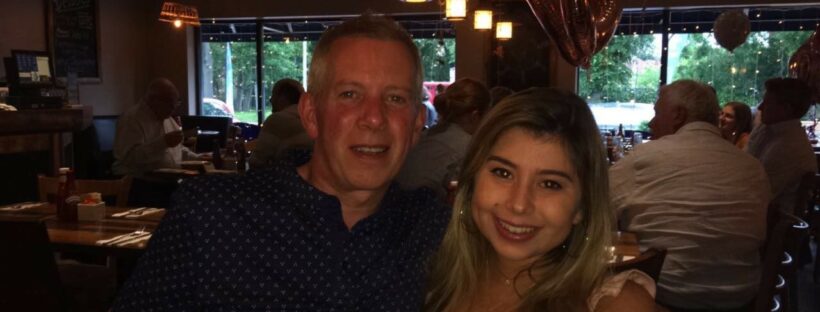‘Opt Out’ Scheme TV Script
I am the producer for this piece and it would be the presenter asking the questions with a live guest.
Interviewing organ donor Adrian Whitaker and recipient Hannah Whitaker, who is a York student, about how organ donation changed both their lives in like of the ‘opt out’ scheme launching from 20th May 2020.
‘Opt Out’ Scheme:
- The law around organ donation is changing in England. This means that from 20 May 2020, all adults in England will be considered an organ donor when they die unless they had recorded a decision not to donate or are in one of the excluded groups.
- Last year, 408 patients died in the UK on the transplant waiting list.
- The changes will not come into effect immediately to make sure there is plenty of time to inform people about what is changing. This will give people time to choose if they want to be an organ donor and to share this decision with their family and friends.
- This system does not include children under the age of 18.
- Families will always be involved with the process and religion and faith will be taken into account.
- A form can be filled out on line if you wish to opt out of organ donation.
- This is often referred to as ‘Max and Keira’s Law’ because 9 year old Max received a heart transplant from 9 year old Keira who died in a car accident. Her father said that she had the kindest of hearts and knew she’d have wanted the chance to help people. Max’s family have been campaigners for the ‘opt out’ system.
- Some people may be ineligible to be a donor due to the age of the organ e.g. if they’re old and the organ isn’t working to it’s full potential anyway, or if they have pre-existing conditions that affect certain organs like cancer or other chronic diseases.
- There is a time limit on how long organs can live outside the body. Kidneys can live up to 30 hours, less than 12 hours for a pancreas or liver and less than 6 hours for heart or lungs.
- When asking around, most people agreed that the ‘opt out’ system was the best thing that could happen for people needing transplants because it means that more people can have their transplant quicker if everyone donates after death. A couple people said that the thought of having your organs taken out is scary because we obviously don’t know what happens after death but knew they can save lives by doing so.
Background Information:
Adrian’s Experience –
Adrian Whitaker donated his kidney to his daughter Hannah in May 2012 after she was diagnosed with full renal failure. He said he felt like it was his duty as a father to help his daughter because he hated seeing her in pain and not able to live her life properly whilst she was on dialysis when he knew there was a possibility he could do something to end her suffering. Adrian said it makes him feel good on the inside that he was able to let Hannah continue her life and is one of his best achievements in life. He said the feeling of donating an organ was very rewarding because he knew he’d saved a life by doing so, and recommended if people are healthy and want the overwhelming feeling of knowing they’ve saved a life, to do the same. He continued to say that after death, you don’t need your organs so making sure they get donated is the best thing to do because in your death, you could be giving the gift of a new life to someone.
It took him five weeks to recover from the operation and a further two weeks due to an infection but he said it was well worth the short amount of suffering he went through to watch his daughter begin to her life to the full and watch her turn into a young adult. Adrian talked about the small implications he’s had since donating his kidney and said the only real problems he’s had is fluctuating blood pressure but he already had high blood pressure before donating so doesn’t find it too hard to handle. He also has toxin level issues but these are monitored and under control.
With the ‘opt out’ system, Adrian said he thinks this should have been obligatory years ago. The opt out scheme is a good thing because it means so many more people will have the chance or transplant. Unfortunately, when people die and they aren’t a registered organ donor, their organs can’t be taken and by the time their death has been recorded or someone has been in touch with the family to ask, it’s too late as the organs can only last so long.
Hannah’s Experience –
Hannah has been living her life to the full since receiving her transplant from her Dad. She needed the transplant due to complete renal failure at 11 years old but the doctors could never work out why this happened; it could have been due to her own kidneys being deformed from birth but they are unsure.
She was on two different types of dialysis for 9 months before she had her transplant; one which she would have 3 days a week for 3 hours at a time making her miss 3 half days at school and for this she would have to go to the LGI and be connected to a dialysis machine by tubes permanently fitted in her body just below her collar bone which allowed her blood to be taken out, cleaned by the machine and put back in. She would have to sit still during this time but would do school work, draw and watch films. This happened for 4 months before she had an operation to fit a tube in her stomach so she could do dialysis at home. This would take place every night and the machine would put fluid into her stomach through the tube, leave it there so it could collect the toxins and then drain the fluid out. Fluid would be left in her stomach while she was at school and would be drained when she got home, before starting this process again when it was night. She was only allowed to consume 250 millilitres of fluid at this time because if she had any more it could lead to the heart working too hard and possible heart attack, this fluid included milk in cereal, watery fruits etc.
She was 12 when she had the transplant at the Leeds General Infirmary and has had no major problems with her transplanted kidney since. Adrian had his kidney taken out in St James Hospital in Leeds as this was the adult hospital whereas the LGI specialised in paediatrics so Adrian’s kidney had to be put on ice and driven to where Hannah was. Kidney’s can survive on ice outside the body for up to 30 hours if on ice and the hospitals were a short 8 minute drive away from each other so Hannah was told when the kidney had arrived and had been prepared for this so that she could go straight into the operating theatre.
It has been eight years and she has to take daily medication which includes immunosuppressants to stop the kidney rejecting and drinks three and a half litres of water a day to make sure the kidney is constantly hydrated. She will have to take these medications for the rest of her life. Unfortunately, due to how young she was when she received her transplant, she will have to have another one in later life due to the kidney not being able to work to its best ability in a different body. She has come to terms with this and is just working on keeping her transplanted kidney healthy at the moment. Hannah was in hospital for two weeks after her transplant and was very happy to no longer require dialysis which she said was an uncomfortable process.
Hannah was asked to speak at an event for the 4000th kidney transplant in Leeds. There were four speakers who all had a different experience with transplantation. With Hannah being the youngest at 15 years old, she was the representative for the paediatrics in Yorkshire and spoke in front of over 200 doctors, nurses and health care professionals.
Hannah and Adrian are now very close and feel as if this has given them an extra special bond.
In regards to the ‘opt out’ system, Hannah thought it should already be in place due to the length of the transplant waiting list and people often dying waiting for an organ that could have potentially been given from a deceased donor if they were an organ donor.
Due to the coronavirus outbreak, Hannah and other people with underlying health conditions have been told to isolate for a minimum of 12 weeks. A few weeks in, the ‘high risk’ category were told they were only allowed to open a window meaning they couldn’t sit in their gardens let alone leave the house. Recently they have been told they are now allowed to go outside but should get food deliveries to keep them as safe as possible and avoid any contact with people outside their household as these people have more chance of contracting the virus. In Hannah’s case, she is on immunosuppressants to make sure her body doesn’t reject her kidney meaning her immune system cannot fight anything itself and she can usually be hospitalised for a normal infection. Adrian is not classed as high risk but is also taking all the precautions necessary to protect himself with the fact he only has one kidney.
Possible Questions for Presenter:
For Adrian –
- What organ did you donate and when?
- What made you become an organ donor?
- How do you feel having donated an organ?
- How long did it take you to recover after the operation?
- Has there been any implications since donating your organ?
- What would you say to someone contemplating organ donation, whether it be before or after death?
- Why should people sign up to donate an organ, whilst the ‘opt out’ system is yet to be put in place?
- What is your opinion on it being obligatory to become an organ donor after death with the ‘opt out’ system?
For Hannah –
- Why did you need a kidney transplant?
- When did you have the operation and where?
- What effect did it have on your everyday life when you were ill?
- How do you feel about your dad donating his organ?
- What difference has the transplant made to your everyday life (what can you do now that you couldn’t do before)?
- How do you feel about knowing that you will have to have another transplant one day?
- What are your thoughts on this new legislation?
Presenter Cue:
The law around organ donation is changing in England. The new ‘opt out’ system, also known as ‘Max and Keira’s Law, will commence from 20th May 2020, meaning all adults in England will be considered an organ donor when they die unless they had recorded a decision not to donate or are in one of the excluded groups. Today, I am joined by Adrian and Hannah Whitaker to talk about their experience with organ donation and how it changed their lives, as well as what they think of the new law.
Rainbow Flag VT Script
I am the director of a VT about what it’s like to be part of the LGBT community and the appropriation of using the rainbow flag as a symbol for the NHS.
Interviewing Ben Wilkinson, a York student about his experience in the LGBT community, the charity he works for and the representation of the rainbow flag.
Rainbow flag:
- https://www.google.co.uk/amp/s/www.forbes.com/sites/jamiewareham/2020/05/06/should-the-lgbt-community-call-out-nhs-appropriation-of-rainbow-flag/amp/
- The rainbow flag is a symbol for peace and hope universally.
- For the last 42 years, the rainbow has been recognised as a symbol for the diversity in the LGBT community.
- People are now using the flag to show their solidary with the NHS workers, with the flag being shown in many home all over the UK.
- This has left some in the LGBT community feeling as if they are losing their symbol.
- Some are worried that the flag may be overtaken.
- Buyers are searching for rainbow flags to put in the windows without knowing the actual meaning of the symbol.
- If people are aware of the meaning, they are repurposing it signify unity with the NHS workers.
- In the history of the rainbow flag, Gilbert Baker put the flag together in 1978. All six colours come together to make one whole, making it a powerful symbol for community.
Background Information:
Ben Wilkinson is a student at York St John and he is part of the LGBT community as well as a representative for the charity ‘Just Like Us.’ Ben himself identifies as a gay, cis gender male and he came out around three years ago to his friends. He was welcomed by support from all his friends and was happy he could finally be himself around people, as if having a weight lifted from his shoulders.
Ben has never felt personally discriminated against because of his sexuality but felt as if the community doesn’t yet receive the level of representation as it should, despite its improvement over recent years. However, he has had two incidents in which he experienced discrimination, one being when he was holding hands with his boyfriend and someone shouted a slur, and another when he kissed his boyfriend on the cheek in a taxi but was able to report the incident.
Ben commented on his experience in the LGBT community to be nothing but a positive one. He has found that being part of a group of people who are like him, share his interests, share the same music tastes and attending the famous ‘G-A-Y’ clubs in Manchester and London to be his favourite parts of being in the community. He says that his life is now so much better that he can be himself and be part of such a welcoming, vibrant and amazing community.
Ben works for the charity ‘Just Like Us.’ It’s a charity for LGBT+ people and aims to educate children and eliminate homophobia in schools. He and other representatives go into secondary schools and deliver 10-15 minute talks, about them and their lives, giving young people key information such as definitions of terms such as gay, asexual, lesbian, bisexual etc. After the talk, the representatives ask if there’s any questions and the young people are free to have a private conversation at the end of the session. Ben is also part of the Media Working Group for Just Like Us, so he helps them handle their social media channels. He provides his advice about what works for each platform, what will get the most interactions and thinks about campaigns the charity can run in the upcoming months. Just Like Us is on track to be one of the UK’s top LGBT charities, having had appearances on This Morning, Good Morning Britain and doubling their ambassadors this year. ‘Just Like Us’ opens the door to many other opportunities for Ben too, as he was invited to a specialist training course in London with Blackrock, the world’s largest assets management company. He has been invited to multiple prestigious LGBT events because of ‘Just Like Us.’
With regards to the rainbow flag representation, in Ben’s opinion he doesn’t think it’s necessarily a bad thing to use it to spread positivity during this scary time. He does however think it will become a problem if people try to solidify the flag as a symbol of the NHS once the pandemic is over, after the LGBT community have fought over the last 50 years to have the rainbow flag represent their equality and existence in society, and it is their only mainstream symbol/logo in society. But, for this moment in time does not see the problem in using it to celebrate the bravery of the NHS workers and unite with them.
Vox pops/other people’s opinions on the representation of the rainbow flag:
When researching into this, I found that the majority of young people thought the use of the rainbow flag to show the public’s support of the NHS was wrong. Some of the main arguments against it’s use were that the rainbow symbol has never been linked to the NHS before so why now, the NHS colours are blue and white so they already have colours used to signify them and there has been an outcry due to people selling rainbow flags on eBay and labelling them as ‘thank you NHS’ flags.
I also found that some young people thought the older generations were refusing to acknowledge the symbolic meaning of the rainbow flag as they displayed them to thank the NHS in their windows and some young people I spoke to thought this was because of their lack of gay acceptance in history. One person disagreeing with the ‘rebranding’ of the flag made the point that we wouldn’t use the same flag to represent two different countries so this should be no exception, especially when the LGBT community has worked hard to claim rights over the flag in the first place. The fact that the flag can be stripped of them so easily shows that some members of the public still have no appreciation of gay rights and furthermore shows the community’s existence as a minority group.
However, when speaking to some people from older generations, they saw no problem with the use of the rainbow flag for thanking the NHS and associated the symbol of a rainbow as something of unity and hope. Although, this may still be linked to the fact that gay rights hasn’t historically been a priority and the lack of gay acceptance with this only becoming the norm over the past couple of decades and would seem to be improving, apart from this debate.
Script:
In the circumstances of the coronavirus outbreak, I would film from a 2 metre distance. This would ensure both our safeties as well as allow for a good camera angle. I would attach a presenter and interviewee lavalier mic so that both people can be heard when asking/answering questions and this will also be good for safety reasons as both mics will pick up sound clearly whilst the interviewer and interviewee are far apart.
VO – The public of the UK have been showing their thankfulness for the NHS who are working on the frontline of the coronavirus pandemic, and people have been doing so by displaying pictures of rainbows in their windows with the slogan ‘thank you NHS.’ Others have gone further by using rainbow flags to show their solidary. However, before this the rainbow flag has commonly been used as a symbol of the LGBT community and some have had something to say on the ‘rebranding’ of the symbol that they’ve fought so hard for.
IV – Ben talks about who he is and a bit about his story.
VO/PTC – Ben has been a representative for a charity based in London for the past two years now that helps young people find their true identity and not be afraid of being who they really are. In light of the coronavirus outbreak, he has been doing talks via video call.
IV – Ben explains what he does for the charity and what the representation of the community means to him. Include symbolism of the rainbow flag to introduce the next discussion.
VO/PTC – Like many other people in the LGBT community, Ben has often used the rainbow flag to symbolise that he is part of that group of people. However, during the pandemic, the public have taken the rainbow image and made it a symbol of solidary with the NHS during these difficult times. When speaking to Ben and different members of the public, I found there was a mixed opinion on the ‘rebranding’ of the rainbow flag, with the generation that the person being interviewed was brought up in having an effect on their outlook.
IV – Interview Ben on the matter and feature vox pops of the different opinions that the different age groups had. If vox pops needed to be done under the current circumstances, either skype volunteers or interview at a safe distance.
VO/PTC – On average, young people disagreed with the use of the rainbow flag being used to support the NHS due to it being symbolic of the LGBT community. Whereas, people over the age of around 40 that were not part of the community didn’t see any harm in using the rainbow flag. It seems we will have to wait until after the pandemic to see just what happens with the rainbow flag and whether it continues to be used to show solidary with the NHS or whether the LGBT community can regain the symbolism of the flag they worked hard to get. I’m Hannah Whitaker and this has been Yorkie Today.
Ideas for the VT:
GVs:
- Ben in Durham in his house and places nearby because this is where he grew up and where he came out to his family and friends.
- The hospital in Durham to represent the NHS.
- Rainbow flags that Ben owns that represent the LGBT community.
- Rainbow flags in people’s windows and in the streets.
- Important landmarks in Durham such as Durham Cathedral.
- Any NHS vehicles.
- The headquarters of the ‘Just Like Us’ charity and anything associated with it e.g. posters, film ben doing a talk.
- Streets of York.
Interview:
- Ben sitting outdoors with nice backdrops.
- Ben in his room with his flags on display.
- In the headquarters of the charity.
Voiceover:
- Introducing Ben.
- Introducing the charity.
- Talking about the representation of the flag.
Possible Questions for Presenter for Ben:
- What is your sexuality?
- What do you identify as?
- Have you come out and if yes, how was your experience?
- If you have, who did you come out to first and why?
- Do you feel like you are discriminated against because of your sexuality?
- Have you ever been abused for being who you are? (Verbally/physically/mentally)
- What’s your experience been like within the LGBT community? (Is it welcoming etc)
- What charity are you involved in?
- How do you feel about the ‘rebranding’ of the rainbow flag?
Stills Photography Task – Nature
My collection of photos were taken with the theme of ‘nature’ in mind. I decided on this theme because it meant I could go to a variety of places such as reservoirs and parks to find the best-suited images, including flowers, trees, and water.
Reflection –
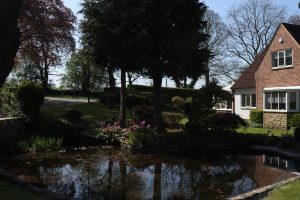
Shallow depth of field –

Silhouette –

Long exposure –
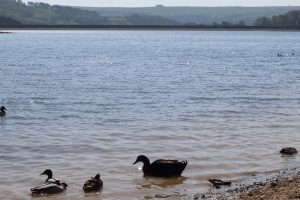
Frame within a frame –

For my stills photography task, I decided to run with the theme of ‘nature’ because I thought this would give me a variety of ways to go about the task, when it came to location and photo opportunities. This meant I got photos of various flowers, trees, animals and water. This was an individual task which meant I had to use my creativity and camera skills to get the best images I could that fit the brief: five photos consisting of a frame within a frame, a silhouette, a reflection, a shallow depth of field and a long exposure shot.
An example of the health and safety precautions I took was the fact that I was taking photos of/near water. I made sure that I didn’t go to close to the water with the equipment to avoid water damage. I also made sure I was aware of my surrounding when taking photos. “You might bump into someone while walking backwards trying to grab an interview.”(Chapman, J and Kinsey M (2009). Broadcast Journalism A critical introduction.)
I was trying to achieve a collection of photos that would come under the theme of nature. When it comes to the audience for this task, the photos could be aimed at anyone who enjoys the outdoors or simply the beautiful nature to be seen in the local area. “The audience has long been said to be active in the sense that people bring their own interpretations to the media output.” (Harcup, T (2015). Journalism Principals and Practice.)
The only problems I ran into with this task is getting the camera settings right to get the long exposure shot. To get over this problem, I went through the settings individually and had a look at PowerPoints from previous workshops as well as using my camera skills training to sort out this issue.
Bibliography:
Chapman, J and Kinsey M (2009). Broadcast Journalism A critical introduction. Oxon: Routledge. p88-89.
Harcup, T (2015). Journalism Principals and Practice. 3rd ed. London: Sage. p220.
Mojo Task – Bronte on Femme Magazine
I decided to do a mobile journalism piece on my friend Bronte’s magazine ‘Femme’. This was an artefact I produced by myself, doing the filming, sound, editing etc, which meant I got the experience of doing the whole process by myself which is essential when an opportunity for mobile journalism comes up. One health and safety problem I encountered was filming next to roads but to overcome this I ensured that when filming we were on the path and both myself and the interviewee were safe when we came into contact with roads and passing/stationary vehicles.
I wanted to achieve an easy-to-watch minute-long video which gave a bit of information about what the magazine involved and some of the background as to how it got up and running. “Mobile devices and social media allow journalists to strengthen their connections with the public and ultimately better serve them.” (Adornato, A (2018). Mobile and Social Media Journalism)
I learnt the many ways of editing with iMovie with this task, which is ideal for mobile journalism. “It’s an easy-to-use app for video stories that require a combination of visuals and audio tasks.” (Adornato, A (2018). Mobile and Social Media Journalism)
Using iMovie meant I could easily edit my artefact, making it look professional and interesting for an audience of fashion lovers and young people, due to the format of the production. “It might be a very general audience – people with all sorts of backgrounds and interests, or it might be very clearly defined.” (Bull, A (2016). Multimedia Journalism A Practical Guide.)
Bibliography
Adornato, A (2018). Mobile and Social Media Journalism. London: Sage. p4-107.
Bull, A (2016). Multimedia Journalism A Practical Guide. 2nd ed. Oxon: Routledge. p15.
Studio Task – Student Overload
Password – overloaded
The studio task consisted of creating a 5-minute video targeted at young people aged between 18 and 24. As a group, we had a few days to collect two vox pops and two presenter-led VTs, which we did about exercise (at a trampoline park), accommodation, Fossgate festival, and the minister.
We had to decide how we were going to film the VTs to ensure the best viewing experience. “A group task is usual, often about pitching different multiplatform content ideas around a single news event.” (Stewart, P and Alexander, R (2016). Broadcast Journalism Techniques of Radio and Television News.) We decided on using iPads, a form of mobile journalism to get the best content outside of the studio, and professional cameras when in the studio.
In terms of health and safety, each group had to consider any issues they would encounter outside the studio. For example, when we went to the trampoline park ‘Energi’, we had to think about slipping, tripping and falling when it came to filming whilst jumping or around uneven surfaces. We overcame this by ensuring we were careful with the placement of equipment and when filming.
A problem we faced with this project was timing in the studio. Being a presenter, I had to make sure I filled the gaps between the VTs with relevant information to make the video flow. This took a couple of rehearsals to get right, as well as the people running the VTs at the right time.
Bibliography
Stewart, P and Alexander, R (2016). Broadcast Journalism Techniques of Radio and Television News. 7th ed. Oxon: Routledge. p14.
SU Elections Task – Interview with Tim Holmes
For the SU Elections, we had to work in groups to interview a student running for a role in the SU such as SU president. I had the role of monitoring the sound levels, so this meant operating the boom pole, attaching the microphone packs to the interviewees and making sure the sound coming into the camera was clear.
We had to make sure the interviewee was aware of wires, even though we stuck them to the floor, to make sure he didn’t trip over anything unexpected. We also asked for consent from the interviewee to show the completed video as an artefact. “It is normal to seek consent before the research starts.” (NSPCC. (2018). Research with children: ethics, safety and avoiding harm. Last accessed 21st May 2019)
I was trying to achieve a suitable video to show in the SU for the promotion of Tim Holmes, who was running to be the SU president. A potential problem that could’ve been found when interviewing is not making the interviewee feel comfortable. We made our interviewee feel at ease by introducing our team and getting to know him, as well as giving an insight into what we would be asking before the interview commenced.
We wanted to make sure the interviewee said everything he wanted to, as the interview was not only for our benefit but for his campaign. “It is always good to ask towards the end: “Is there anything else you’d like to add?” It is polite and stops the interviewee feeling annoyed that they didn’t get chance to talk about their pet subject.” (Harcup, T (2015). Journalism Principals and Practice.)
Bibliography
Harcup, T (2015). Journalism Principals and Practice. 3rd ed. London: Sage. p135.
NSPCC. (2018). Research with children: ethics, safety and avoiding harm. Available: https://learning.nspcc.org.uk/research-resources/briefings/research-with-children-ethics-safety-avoiding-harm/. Last accessed 21st May 2019.
The dangerous side to rugby
The ‘rite of passage’ road for students in Yorkshire
The Otley Run, to the untrained ear, can be misinterpreted as a marathon you might spend months training your body for. However, it is actually a run of pubs that people still train for, but more like training their bodies to handle the number of alcoholic drinks expected to be consumed at every pub on Otley Road.

The Otley Run is often seen as a rite of passage for students all over Yorkshire, hoping to say that they completed the run without getting alcohol poisoning or completely breaking the bank on the way. The aim is to drink one alcoholic drink at every pub on the run, no matter what it is as long as it’s a pint or a double, and with the road consisting of 18 pubs, there are very few people that can say they’ve completed the Otley Run.
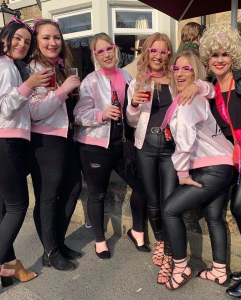
It is known for groups of people dressed up in costumes as they neck a pint of anything and everything, beginning to struggle by the fourth pub and even though a group theme is not a necessity, it is certainly better to see than a group made up of a cowboy, a smurf and a tennis player randomly put together.
“I heard about it through word of mouth from friends/family/co-workers and serving customers who participated in the Otley Run.” Olivia Jessuk, 19, is a student grew up in Alwoodley, Leeds, not far from the famous Otley Run route.
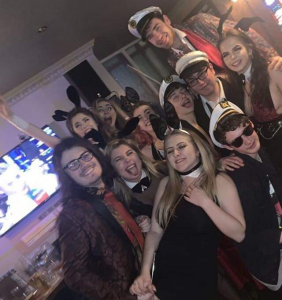
In true Otley Run style, Olivia wanted to dress up as a group to make the night more fun and interesting as well as being controversial. “The girls went as playboy bunnies and the boys as Hugh Heffner.”
Being a student, Olivia talked about why she thought it was her time to experience what everyone had been talking about. “It could possibly be considered as a rite of passage because there’s a level of anticipation leading up to the Otley Run and for many students in Leeds and the surrounding areas, it’s a big transitional period into being a ‘true’ uni student, from the outfits to competing with mates over who made it to the final destination.”
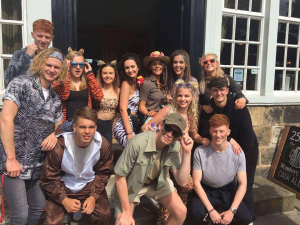
The Otley Run has been thought of as a rite of passage for some time it seems, as Adrian Whitaker talks about doing this same route over 20 years ago.
“Even back then I think it was seen as a rite of passage for students because it was almost as if you had something to prove, prove you could drink like an adult and being able to say that you did the Otley Run was thought of as a great achievement.” This just shows the run as something every student wants to experience and say they’ve tried, if not completed because it’s something you wouldn’t want to miss out on.
